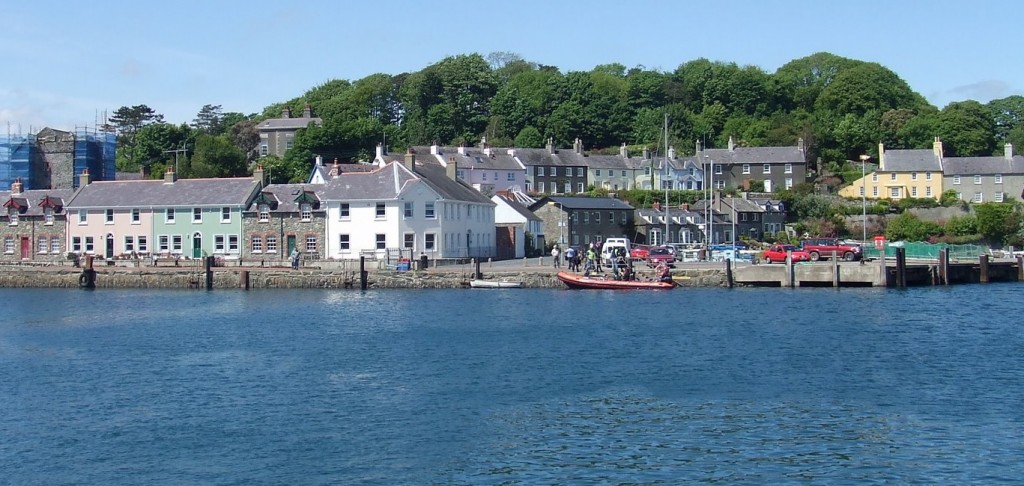Waiting for the ferry I watch Strangford Lough tighten and boil whitely through a last narrow chute. Somewhere beyond a horizon made brief by sullen clouds, it spills into the Irish Sea. Beyond the crossing sits the Portaferry quay and behind it a steep hill. It is a sunless Monday morning in October. Bored commuters ignore the scent of salt water and the screaming gulls. When they hear the bass rumble of the ferryboat’s diesel the men prepare to board by shuffling their newspapers closed and getting into their cars. The women rearrange the children in their prams.
The ferry ride lasts all of five minutes, but the short, steep chop and strong breeze feel bracing and fresh, an antidote to the achromatic day and the feeling that every day is the same. Map of Ireland in hand, golf clubs in the boot, I am bound north, from Newcastle to the Ards Peninsula, a hook-shaped prominence south and east of Belfast, for a round at the Kirkistown Castle Golf Club.
Designed by the great golfer and course designer James Braid, who called it “an eerie, exposed course,” it is not easy to get to. For my purposes, I count that good. The combination of a great architect and a remote location is the promise of Kirkistown.
There are a great many out-of-the-way courses that have been hauled from obscurity into the light of day. Still, I’m sure there are worthies that have not. I would like to find one or two. The getting there is half the fun, and in most cases, all of it. If you do not feel this way about these things, then this sort of exploration is not for you.
Once across and over the rise, I am in sheep-raising country, following twisty, hedge-lined roads, passing through ancient villages with names like Clough and Churchtown. There is mud everywhere on the roads, brown and red, in stripes and clumps, for the roads belong as much to the farm tractors as they do to the cars. A mist begins. Too light to fall, it hovers, integrating itself into the grey light and the brown and red mud.
Hungry and in need of a directional tweaking, I stop at a pub. It is not quite noon and I know Kirkistown is not far. In the pub three young farmers are leaning on the bar drinking their pints. One is quite drunk, and the other two not drunk at all. All wear black Wellies and mud-colored overalls and yellow slickers. They are covered with mud, vestments of mud. Their faces and their hands are red from weather and hard use. The drunken farmer asks me if I am a Yank. I affirm, and he offers me a thrashing for it. His mates take an arm each and tell me no bother; he’s harmless. He argues the point. He is, he says, far from harmless. His friends buy me a pint. I drink it and am on my way, undirected but uninjured.
The mud, the mist, the easily understood temptation towards an early cocktail hour, all conspire to make Kirkistown feel truly remote. The road emerges from the farmland and starts heading due north, hugging the Irish Sea. The seaside location of the course suggested by the map seems ratified. I feel a score coming on.
No. The road in fact hugs the beach quite tightly, too tightly to place a golf course between it and the water. When I spot a very modest sign directing me to the clubhouse, it is on the landward side. So much for a links course. The pro is genial, lanky. His shop is more like a tool shed than a pro shop’s display set-up. What he has to sell is limited almost entirely to what a round of golf that day might require: tees, balls, gloves, ball markers featuring the course logo, trolley handles, rain gear, golf shirts packaged in odd glassine bags.
The course is deeply undistinguished. It is, of course, treeless, but it doesn’t have much else to shape it, either. No gorse, no humps and hollows. The bunkering is minimal. Most of the holes are dead straight. Its most profound feature is a mesa-like rise in its center. Braid in his routing of the course used it whenever possible, but it adds no interest. The land is so flat otherwise, and the hill so abrupt and brief, that the sudden rise plays less as the leit motif of the golf course than as an impediment to any kind of rhythm. Hole by hole I whittle the course away, eager to be finished. I feeI less like a golfer than a commuter trying to make a train. In Kirkistown’s topography, Braid simply had far too little to work with. Good golf ground in Ireland is like its roadways, all gentle heaves and twisty hollows, and that topography I had negotiated with a steering wheel, not my golf clubs.
When I play locally, I occasionally partner up with a native of Ireland, and I ask him for the best obscure course he knows of. I always get a thoughtful answer. I write the unfamiliar names on my scorecard so they don’t escape memory. Often these courses have a website. If it is an unpolished website, good.
Braid’s description of Kirkistown holds up. It is exposed, in the way an airport runway is exposed. It is eerie, in that a landform more appropriate to Arizona than the north of Ireland erupts from its center. So it goes. Panning for little-known and very good golf courses, there is no such thing as Fool’s Gold, only Next Time. I have some names saved up. I’ll keep at it, because you just never know.

